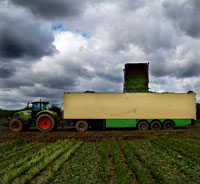Harvest weather forecast to improve

Farmers were preparing for a late harvest rally today (Friday, 27 August) after dry weather was forecast for most of the UK next week.
Many parts of the country, especially the south, have been recently blighted by rain, which has hampered work and increased concerns about crop quality and diseases.
But Met Office forecaster John Hammond said most farmers could expect “a week to 10 days” of dry weather.
“Over the weekend, scattered showers are likely in some northern and eastern areas, but elsewhere it will be dry,” he said.
“High pressure will drift across the UK next week, bringing cooler nights and drier days. It’s an improving picture.”
Shropshire and West Midlands
Harvest was going slow in Shropshire and the West Midlands, with 35% of the wheat cut so far, said Julian Walker at Shropshire Grain.
“Hardly anything has been done this week, but the forecast is good for the next 10 days so we’re hopeful harvest will be wrapped up by then,” he said.
Mr Walker was hopeful that quality would be good, although yields were still unknown.
Eastern England
Philip Darke, managing director of Camgrain, said on Friday that around 30% of farmers had finished harvesting.
Winter barley, spring barley, oilseed rape and Group 1 and 2 wheat crops were “effectively finished and in storage”.
Milling wheat quality has been good because farmers have been allowed to cut wheat at 20-25% moisture for a £7/t drying charge, he added.
However, Group 3 and 4 wheats that were still standing in fields were sprouting.
“We have still got a sizeable tonnage out there that is not going to have a hagberg,” said Mr Darke.
“Hagbergs were around 150 on Solstice on Wednesday (25th August) and it has been raining ever since.
“One farmer in Bar Hill, Cambridge, has Viscount and that has got sprouts all over it. It’s a nightmare.”
Western England
Independent AICC agronomist Dan Dines, who advises 25 growers in Dorset and Wiltshire, said some farms have nearly finished harvesting.
“The bigger units still have around 40-50% of their wheat to cut. It varies from farm to farm.”
Combine size, crop-drying and the moisture levels at which growers are prepared to cut are influencing the amount of work completed, he suggested.
“The moisture levels they are cutting at have gradually increased as time has gone by,” he added. “We haven’t had a full day’s combining here for almost a fortnight.”
Sprouting has begun in places and he predicted it will soon be widespread if damp conditions remain.
However, in the North West, Northern Ireland and Scotland, harvest appeared to be progressing well.
North West
North-west independent agronomist Paul Sweeney said on Friday around 70% of wheat had been cut.
“Yields are extremely variable. Light land has suffered, but heavy land has held up remarkably well and some farmers have had exceptionally high yields.”
No significant disease concerns have been reported, he added.
Wales
Harvest was on target at Meurig Raymond’s Trenewydd Fawr, in Haverfordwest, Dyfed, at about 60% complete.
|
|---|
“We have not had a lot of rain over the last few days, but with dry weather forecast for next week, we are revving up to go,” said Mr Raymond.
So far, spring barley yields were down to 7.5t/ha from 7.7t/ha last year, while first wheat yields are also down to 10t/ha from 10.8t/ha.
However, the quality of milling wheats was good. “If the weather settles, I’m hoping we can harvest some good quality with what’s left,” he added.
Scotland
Andrew Gilchrist, managing director of Scottish Agronomy, said harvest was stop-start due to showery weather.
By Friday, around 5-10% of wheat – with yields “holding up quite well” – and 15-20% of spring barley had been harvested in Scotland, he said.
“Spring barley quality is good, although in southern Scotland grain nitrogen tends to be low on crops, especially around Fife,” he added.
Northern Ireland
Clive Coffey, managing director of Clarendon Agricare, based in Portadown, Co Amagh, said up to 25% of spring barley and wheat had been cut by Friday.
“Yields are variable, wheats are good, but spring barley is fairly disappointing,” he said.
“Disease has come in of late, maybe more on barleys. Rhynchosporium has probably done some harm to yields.”


